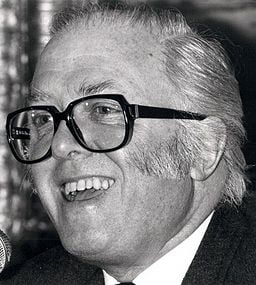
Early Life and Career
The British film actress and singer Jean (Merilyn) Simmons was born on 31 January 1929 in Islington, London. She was the youngest of the four children of Charles and Winifred Simmons. During WW2, the whole family was evacuated to Winscombe, Somerset. During her time in rural Somerset that Simmons she got her first taste of acting and singing. Shortly after moving back to London, the 14-year-old dance student made her film debut. She was hand-picked by director Val Guest to play Margaret Lockwood’s sister in Give Us the Moon (1944). She went on to make two further film appearances that year.
In 1945, Simmons signed a seven-year contract with the J. Arthur Rank Organization. It was also the same year her father died. She landed her first major role a year later when she played the young Estelle in David Lean’s Great Expectations. A 17-year-old Simmons won rave reviews for her portrayal of an Indian girl in Black Narcissus (1947). In 1948, she starred opposite Laurence Olivier in Hamlet and earned a Best Supporting Actress Oscar nomination. She quickly went on to star in a number of other British box office successes. These notably included, the very risqué for the time, The Blue Lagoon (1949) and So Long at the Fair (1950), with Dirk Bogarde.
Hollywood Stardom
In 1950, Simmons married British actor Stewart Granger and moved with him to Hollywood. Granger had only just signed up with MGM Studios. Rank sold Simmons’ contract to RKO Pictures, owned by Howard Hughes. Her first film for the Studio was Androcles and the Lion (1952), co-starring Victor Mature, followed by Angel Face (1952), with Robert Mitchum. Her relationship with Hughes soon became acrimonious after she had reportedly refused his sexual advances.

Simmons in Angel Face (1952). Photo credit: Flickr/CC BY-NC-SA 2.0 DEED
She was William Wyler’s first choice for the female lead in Roman Holiday (1953). However, Hughes refused to give consent to the loan from RKO. The film went on to make Audrey Hepburn a star. A court case freed Simmons from the contract with Hughes in 1952. After the release of Roman Holiday, the ever-modest Simmons said of Hepburn, “I wanted to hate you, but I have to tell you I wouldn’t have been half as good.”
One of her most successful films of the ‘50s was The Robe (1953) when she starred opposite Richard Burton. She was also cast as the female lead in Willie Wyler’s epic Western “The Big Country” (1958). The all-star cast included the Hollywood A-Listers Gregory Peck, Charlton Heston, and Burl Ives. She then went on to star in the highly critically acclaimed Spartacus (1960), alongside Kirk Douglas.
Later Career
From the mid-1960s onwards, Simmons found major film work beginning to dry up. Increasingly she found work on the small screen. However, she still managed to land some quality film work, most notably in The Happy Ending (1969). Her performance earned her a Best Actress Oscar nomination.
Throughout the ‘70s and ‘80s, Simmons mostly worked in TV films and mini-series. Arguably, her best performances came in The Thorn Birds (1983) and North and South (1985). She also managed to make a big screen comeback in 1995, co-starring in How to Make an American Quilt.
In all, Simmons chalked up more than 50 big-screen appearances during her 55-year film career. Her last film and on-screen performance was as Hannah in Shadows in the Sun (2009).
Personal Life
Simmons married and divorced twice. In 1950, she married British actor Stewart Granger, who was 16 years her senior. The couple moved to Hollywood the same year, both becoming U.S. citizens in 1956. Their daughter Tracy Granger was born the same year. She was named after a Simmons good friend, the actor Spencer Tracy. After a decade of marriage, the couple divorced in 1960.
In November of 1960, Simmons married film director Richard Brooks. Their daughter, Kate Brooks, was born a year later in 1961. In the late 1970s, after the breakdown of her second marriage, Simmons moved to the East Coast of the US. She briefly owned a home in New Milford, Connecticut. However, after divorcing Brooks in 1980 she made a return to California. She opted to settle in Santa Monica, where she lived until her death.
In the 2003 UK New Year Honours List, Simmons was appointed an Officer of the Order of the British Empire (OBE) for services to acting. Also in 2003, she became the patron of the British drugs and human rights charity Release.
Ill-health and Death
Like many of her acting contemporaries of the era, Simmons had a problematic relationship with alcohol. In 1986, she underwent treatment for alcoholism at the Betty Ford Center in Rancho Mirage. She spoke publicly about her addiction hoping that it would help others.
Simmons died after a long battle with lung cancer at her home in Santa Monica, California on 22 January 2010. She was nine days short of her 81st birthday. Simmons was survived by her two daughters from her two marriages. She was interred in Highgate Cemetery, north London.
Header image credit: Creative Commons PDM 1.0 DEED





